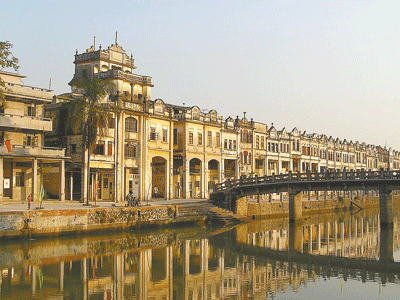 THE Conservation of the Sree Vadakkunnathan Temple in Kerala, India has received the Award of Excellence in this year’s UNESCO Asia-Pacific Awards for Cultural Heritage Conservation. Five sites in China received the recognition as well, including Honorable Mentions for YHA Mei Ho House Youth Hostel in Hong Kong and Sanfang Qixiang in Fujian Province, Awards of Merit for Pingyao Traditional Courtyard House in Shanxi Province and the Guangdong Heritage Education Center in Guangdong Province as well as an Award of Distinction for Saltpans of Yim Tin Tsai in Hong Kong. Last week we toured around Hong Kong. These three are located on the Chinese mainland. Pingyao Courtyard House Location: Shanxi Province Pingyao is a well-preserved ancient town in Shanxi Province. The town was founded in the 5th century and the extant town dates from the 14th century. Covering an area of 225 hectares, the town includes ancient walls, streets, lanes, shops, dwellings and temples. It is home to more than 3,000 exquisitely decorated traditional residences made of gray bricks. The residences are typical courtyards with rooms on four sides. The most striking feature of these houses is the combination of cave dwellings and common houses. In the Ming (1368-1644) and Qing (1644-1911) dynasties, Pingyao witnessed booming commercial development and many families accumulate great wealth through operating big farms and private banks. The pilot restoration of 53 courtyard houses is an excellent model for the conservation of privately owned vernacular buildings. The work was carried out by experienced craftspeople using traditional construction techniques and materials, thus retaining material authenticity while sustaining local building traditions. Transport: Fly to Taiyuan, capital of Shanxi Province, and get to Pingyao by coach. Cangdong Ancient Village Location: Guangdong Province Kaiping City is a UNESCO World Heritage Site because of its unique diaolou culture and the influence of overseas Chinese culture. The diaolous were built at the beginning of the 19th century, mostly by overseas Chinese. These immigrants saved money and returned to their homeland to build the unique Chinese homes using knowledge they gained about Western architecture. At that time, the area was infested with thieves and bandits, so the buildings were designed to be difficult to infiltrate. There are many villages that have diaolous in Kaiping — Cangdong Ancient Village is among the most popular ones. The village contains architectural typologies dating to the Ming Dynasty, which the project selected for conservation, including two ancestral halls, a defensive watchtower and Furen Temple. By designing an outreach program targeting young people, the project helped raise awareness about local heritage among the next generation. The best way to visit the village is by bicycle. Transport: Take a coach from Shenzhen to Kaiping and rent a bicycle there. Sanfang Qixiang Location: Fujian Province Located in the downtown area of Fuzhou, capital of Fujian Province, the Sanfang Qixiang (Three Lanes and Seven Alleys) is a street district featuring a cluster of ancient residential buildings. Covering an area of 40 hectares, it is the largest well-preserved historical heritage site in China. With the Southern Street acting as a central axis, the original three lanes were in the west and the seven alleys in the east. The layout dates back to the Tang (618-907) and Song (960-1279) dynasties, almost 1,000 years ago. The street is unique as it is the only existing street district in China bearing this pattern. The lanes and alleys were home to hundreds of houses constructed by wealthy people of the Ming and Qing dynasties, and 159 buildings remain well-preserved to this day. The revitalization of the district is another outstanding example of conservation planning of individual buildings and larger landscapes. The once deteriorated buildings were restored in an authentic manner using traditional building techniques and materials. Transport: Fly to Fuzhou from Shenzhen, and take a taxi to the site. (Wang Yuanyuan) | 
